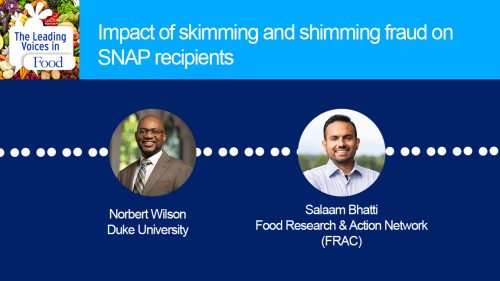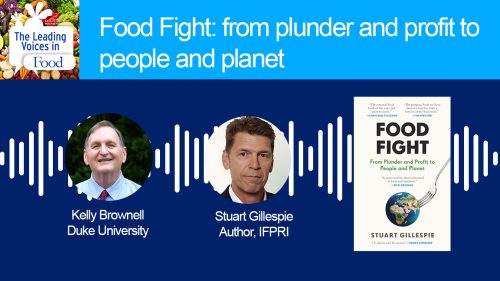The Leading Voices in Food
E199: How USAID is working to reduce wasted food in developing countries
Today we’re looking at food waste and loss on an international scale. Did you know that over 1/3 of the world’s food is lost or wasted? In low- and middle-income countries, over 40% of food loss occurs before a crop even makes it to the market. This food loss undermines efforts to end hunger and malnutrition. Wasted food contributes 8 to 10% of global greenhouse gas emissions. Addressing this challenge is critical to global food security, nutrition, and climate change mitigation.
Subscribe: Apple Podcasts | TuneIN | YouTube Music | SoundCloud | PocketCasts | Radio Public
Tags: Agriculture & Tech | Climate Change, Environment & Food | Food Insecurity | Food Policy | Food Waste & Implications |

Nika Larian is a Food Loss and Waste Advisor in the Center for Nutrition within the US Agency for International Development (USAID) Bureau of Resilience and Food Security. Dr. Larian is passionate about the intersection of nutrition, food safety, and climate sustainability. Nika is the producer of the USAID Kitchen Sink Food Loss and Waste Podcast and Co-Chair of the Global Nutrition Coordination Plan (GNCP) Food Safety Technical Working Group. Previously, she was an American Association for the Advancement of Science (AAAS) Science and Technology Policy Fellow at USAID, working as a Food Systems Advisor. Nika received her Ph.D. in Nutritional Sciences at the University of Kentucky in 2019. Her doctoral research explored the effects of environment pollutants on human health, namely diabetes and obesity. Working at USAID, she has provided technical assistance and policy guidance on US Government nutrition strategies and engaged with colleagues across the interagency.
Ahmed Kablan is a Senior Science Advisor, Center for Nutrition/Food Safety Division/Bureau for Resilience and Food Security/USAID. Dr. Kablan manages several research programs in the area of Nutritious and Safe Foods that includes the Food Safety Innovation Lab, Post-harvest Loss Reduction Innovation lab. Dr. Kablan leads the Nutrition Center’s efforts on Food loss and waste, food safety and nutrition research; member of the Interagency Risk Assessment Committee (IRAC), member of the Interagency Committee on Human Nutrition Research (ICHNR), member of the external advisory boards for the Partnership for Aflatoxin in Africa (PACA), the Food Systems for Nutrition Innovation lab, The Golden Rice & the Food Safety Innovation Lab. Dr. Kablan is a co-lead of the USAID Food Loss and Waste (FLW) community of practices, representing USAID on the UNFSS Food is never a waste Coalition and member of the interagency food loss and waste working group. Dr. Kablan leads the center for nutrition efforts on climate change and food systems and is a member of the USAID climate change technical working group and the USG Climate Change, Food Systems, Nutrition Security, and the Interagency Climate Change and Human Health Group (CCHHG) under the U.S. Global Change Research Program. Dr. Kablan has wide technical expertise in nutrition, food Safety, nutrition-related non-communicable diseases, double burden of malnutrition, metabolic syndrome, food safety & public health.
Interview Summary
Norbert: Ahmed, let’s begin with a question for you. Can you tell our listeners why USAID has decided to prioritize addressing food loss and waste?
Ahmed: Thank you, Norbert. Food loss and waste is increasingly a part of our global agenda, whether we are talking about food security and nutrition, economic growth, or climate change. As you mentioned, 30 to 40% of food produced is either lost or wasted throughout the farm to consumer supply chain. Many of USAID partner countries lose up to 35% of their food annually at multiple points. In the field due to spoilage and damage, while being transported or stored, and when it goes unused by consumers. Nutrient-dense foods, such as fruits, vegetables, dairy, and meat are highly perishable and often lost due to bruising or spoilage, thus decreasing nutrient-rich foods in the market. These losses equate to one out of every four calories intended for human consumption, enough to feed 2 billion people. According to the World Resource Institute, just a 25% reduction in food loss and waste across the world would decrease the food calorie gap by 12%.
On the climate mitigation side, emission from food loss and waste create nearly 8 to 10% of all greenhouse gas emission. If food loss and waste was a country, it would be the third largest emitter. The global food crisis requires us to think about accelerated pace of change, and in many ways food loss and waste is a low-hanging fruit. The investment in time and energy to grow it are already made. Now we are maximizing its benefit. There really is a huge opportunity. Food loss and waste is a triple win. It will improve nutrition and food security. It will improve income for small order farmers, but also for others all along the supply chain, so it can be a force multiplier for job creation. It is a great entry point for our agenda for improving opportunity for women and youth, so it has an equity component, and it is important for addressing climate crisis.
Brenna: Nika, turning to you. I understand that part of your role at USAID is to produce a podcast called “Kitchen Sink Food Loss and Waste.” What was the rationale and objective of creating the podcast, and what are your plans for the future?
Nika: The monthly USAID “Kitchen Sink Food Loss and Waste” podcast was an idea born from the USAID community of practice to increase awareness and promote knowledge sharing among USAID staff, implementing partners, and development professionals. The podcast began with a 101 episode, explaining what food loss and waste is, why we should care, and how we can reduce it. We have episodes featuring experts speaking on technical topics ranging from the role of the private sector and youth in reducing food loss and waste, to solutions that include post-harvest handling innovations and cold chain. In a special December 2022 episode with USAID’s Dina Esposito, Bureau for Resilience and Food Security, together with Senior Climate Advisor Ann Vaughan, the episode explores USAID’s prioritization of food loss and waste, and the triple win opportunities inherent in food loss and waste programming, that engages women and youth while emphasizing nutrition.
We are now available wherever you listen to podcasts. Each episode has an audio-only format, as well as a video recording that can be found on YouTube. We hope to reach a wider audience, including organizations, private sector members, and individuals interested in reducing their own food loss and waste. We have some exciting upcoming episodes with different formats, including a food loss and waste storytelling episode with a dramatic reenactment similar to “This American Life,” and case studies for missions.
Ultimately, it is our goal to increase the frequency of episodes to two per month, and to continue to feature high-level speakers and technical experts, including our inter-agency colleagues. The podcast has proven to be a great way to connect internally and externally, and has sparked excitement and interesting conversations. I love receiving emails from individuals I haven’t previously interacted with because of their interest in the podcast. And we’re always open to suggestions for topics and speakers, so I encourage anyone listening to reach out. The podcast is a new medium for us, and one that has not only been successful in raising awareness, but has also been quite fun to work on.
Brenna: Norbert and I have been doing this for a little bit, and it is really fun to talk to other people about food loss and waste, and thanks so much for sharing what you all are doing. It seems really fun to listen to a dramatic reading about food waste, so I’ll have to watch for that in the future. Ahmed, turning to you now. Could you talk about what USAID is doing internationally to address food loss and waste and incorporate climate and methane mitigation?
Ahmed: Thank you for this question and I’m glad you asked it. At the UN Food System Summit last year USAID announced its commitment to address food loss and waste, including investing $60 million over five years in new research contributing to critical evidence-driven solutions to reduce food loss and waste. This includes support for Feed the Future, the US Government Global Hunger and Food Security Initiative led by USAID. The Feed the Future Innovation Lab for Post-Harvest Loss Reduction is working in with collaboration in Ghana to locally produce technologies that will thoroughly dry and safely store grains for future use. Technologies like this are critical as more than 750,000 metric tons of maize are lost each year to rot and disease across the country contribute to over half million metric tons of greenhouse gases. The Women Poultry Association has adopted these technologies to help them overcome those harvest challenges. With the proper drying and the storage of maize enabled by these technologies, farmers and association member, Josephine Evans, has been able to increase her flock of birds from 1000 to 50,000 over five years. Successes like these have helped farmers endure a historic climate change related maize shortage and continue providing animal source food to maintain food and nutrition security.
Additionally, the Feed the Future Innovation Lab for Food Processing and Post-Harvest Handling has been doing some exciting work with youth in Kenya, linking youth groups with agro-dealers to incentivize youth to sell food loss and waste reducing imports such as hermetic bags and moisture meters to smallholder farmers who were underserved by existing input supply chains. The Innovation Lab and their Kenya partners worked with over 300 youth and did a randomized control study to look at what was most successful. Youth were given a small amount of imports, for example, bags to sell to farmers. Youth with existing assets like motorcycles or small businesses made net profit of $75 a month, while youth with less assets only made $10 more a month and were less successful in sale. Figuring out how to make sure we can help uplift youth at all income levels will be important. These examples highlight how food loss and waste initiatives can be beneficial for growing the income of women and youth along with improving nutrition.
Additionally, we also invested supplemental funds provided by the US Congress in response to the global food security crisis. Part of these supplemental funds were used to fund food loss and waste partnership facility. It’s currently open for application by small and medium enterprises in Bangladesh, Kenya, Nepal, Nigeria, Niger and Tanzania. These countries have been hard hit by Russian invasion of Ukraine and have high-level food loss and waste. So this targeted and timely investment can make real difference. Through the market system partnership, food loss and waste partnership facility, businesses can apply for matching grants that will increase the uptake and scaling of technologies and management practices that reduce food loss and waste with any emphasis in nutrition.
As USAID continues to invest in food loss and waste effort, we’ll continue to link our work to other sectors. Food loss and waste is not just a climate adaptation initiative but also an important knock in effect for a climate mitigation, especially as reducing food loss and waste reduces methane emission. I think this is one of the most exciting co-benefit that also gets the broader community and world excited about reducing food loss and waste. Methane is emitted when food brought in the field and transport at market which happens there is not proper storage and of course when food is wasted and thrown out by consumers or wholesalers. According to the IPCC, methane accounts for 30 to 50% global warming. The United Nation Environmental Unit estimates that food loss and waste is associated with methane emission near 50 metric ton per year. Additional measures like a shift to renewable energy and reduction of food loss and waste can reduce methane emission by 15% by 2030. So if we can cut methane emission, as called for by the Global Methane Pledge, by at least 30% from 2020 levels by 2030 which could eliminate over 0.2 degrees warming by 2050 and really buy us more time to deal with other gases that are contributing to climate crisis and making the world a more dangerous place.
Brenna: Thanks so much for sharing those opportunities with us, Ahmed and all the progress that’s already being made in this space.
Norbert: Nika, let’s turn back to you. What is USAID doing to keep food loss and waste as a development agenda priority?
Nika: Thanks, Norbert. Happy to share how USAID is ensuring that food loss and waste remains a priority. We recently launched a food loss and waste community of practice, which brings together our Feed the Future Innovation Lab research partners, private sector businesses, the World Bank and Foundations, along with USAID staff in DC and in our missions to exchange ideas, identify priority focus areas and advance new partnerships. We also have six food loss and waste, “upstander missions.” So named because they will no longer be bystanders to food loss and waste, but are ready to take action to advance this agenda within their food security portfolios.
At last year’s COP27 climate conference there was not only an agriculture theme day, there were also six pavilions on food and an important emphasis on food systems featuring several food loss and waste panels. COP28 will include even more focus on food systems, which will create exciting momentum for food loss and waste. We would love to see food loss and waste as a standalone session or initiative at COP 28.
The US government has joined The Food is Never Waste Coalition, working with Champions 12.3 to halve food waste by 2030 and to reduce food losses by at least 25% with a goal of creating more sustainable and resilient food systems. USAID engages with our inter-agency colleagues including USDA, EPA, and FDA to promote strategic engagement on food loss and waste issues. We have several exciting international food loss and waste workshops in the planning phase for this year.
Of course, we are trying to amplify our messages and promote knowledge management, including through the USAID Kitchen Sink Podcast and by hosting food loss and waste theme months on the Agrilinks website to share learnings and success stories. Country specific data can really help move the needle forward. We’re excited to be working with IFPRI, who has done a deep dive on the economic impacts of reducing food loss and waste. While there are some caveats to the research, cutting food loss and waste in half in Nigeria, for example, could increase GDP by one to 2%, while decreasing poverty and hunger by 4.4%. That’s huge and that will get the attention of finance ministers and other policymakers who are essential to making changes.
Norbert: Wow! Thank you for that response and I’m so impressed by the systemic view that you all are taking both in terms of looking across the food supply chain and how your agency works with other agencies across the federal government and also other international organizations. That’s really wonderful work. I would like to learn a little more about the link between food loss and waste and the food safety agenda.
Nika: I’m glad you brought up the food systems approach because that is definitely an emphasis at the agency and food safety is of course, part of that. I joined the agency as an AAAS Science & Technology Policy Fellow in the food safety division. So, the linkages between food loss and waste and food safety are near and dear to me and as we say in the food safety division safe food is saved food. In a world where as many as 830 million go to bed hungry every night and 420,000 die from unsafe food every year, we cannot afford to lose food due to poor post-harvest management and contamination. Moreover, nutrient dense foods, such as fruits, vegetables, dairy and meat are often highly perishable and lost due to bruising or spoilage, thus decreasing the availability of nutrient-rich foods on the market. Just a 25% reduction in food loss and waste across the world would decrease the food calorie gap by 12%. Improving cold chain logistics, storage facilities and food processing technologies can improve food safety and reduce food loss, improving agricultural led economic growth. Technologies to reduce food waste can also help improve food safety and shelf life. For example, practices or technologies that improve post-harvest handling and processing, transportation and cold chain can improve food safety and reduce food loss and waste due to spoilage. Food that is lost or unsafe cannot be sold. Leading to losses in revenue and impacts on food security and nutrition due to decreases in the amount of food available. Improving food safety systems improves food loss and waste efforts directly and indirectly while increasing access to nutritious food.










